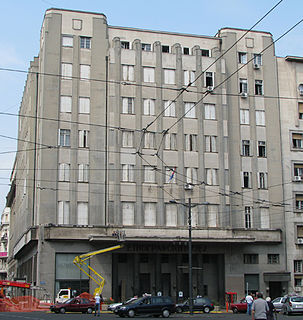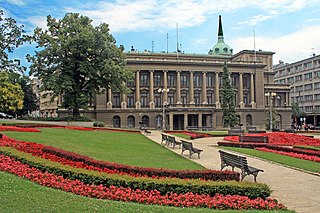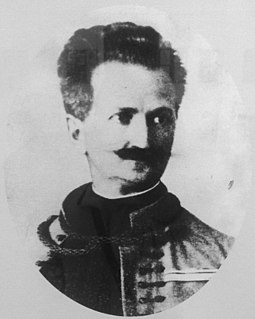
Princess Ljubica's Residence is a palace located in Belgrade, the capital of Serbia. Because of its cultural and architectural importance the residence has been designated a Monument of Culture of Exceptional Importance.
Bara Venecija is an urban neighborhood of Belgrade, the capital of Serbia. It is located in Belgrade's municipality of Savski Venac, along the right bank of the Sava river.
The architecture of Serbia has a long, rich and diverse history. Some of the major European style from Roman to Postmodern are demonstrated, including renowned examples of Raška, Serbo-Byzantine with its revival, Morava, Baroque, Classical and Modern architecture, with prime examples in Brutalism and Streamline Moderne.

The Ethnographic Museum is a museum located in Belgrade, the capital of Serbia. It is one of the oldest museums in the Balkans. The Ethnographic Museum in Belgrade fulfills its mission together with the efforts of various stakeholders in the domain of presentation, revitalization and development of crafts in Serbia.

The Palace of Serbia is a building located in the Novi Beograd municipality of Belgrade, Serbia. The building is used by the government of Serbia and currently houses several cabinet level ministries and agencies.

Architecture of Belgrade is the architecture and styles developed in Belgrade, Serbia. Belgrade has wildly varying architecture, from the centre of Zemun, typical of a Central European town, to the more modern architecture and spacious layout of New Belgrade. The oldest architecture is found in Kalemegdan park. Outside of Kalemegdan, the oldest buildings date only from 19th century, due to its geographic position and frequent wars and destructions. The oldest public structure in Belgrade is a nondescript Turkish türbe, while the oldest house is a modest clay house on Dorcol, the House at 10 Cara Dušana Street from 1727.

Belgrade Cooperative was a cooperative bank founded in 1882 to promote savings and support small enterprises, craftspeople and the poor of Belgrade. Member-shareholders have been paying membership in amount of one Serbian Dinar per week. That is the way for cooperative to become a public savings bank. Luka Ćelović was the first president of cooperative, also a first Serbian insurance group.

The New Palace was a royal residence of the Karađorđević dynasty of Serbia and later Kingdom of Yugoslavia. Today it is the seat of the President of Serbia. The palace is located on Andrićev Venac in Belgrade, Serbia, opposite of Stari Dvor.

The National Bank building in Belgrade is a monument of great importance, located in Belgrade, Serbia, at 12 King Petar St.

The Modern Serbo-Byzantine architectural style, Neo-Byzantine architectural style or Serbian national architectural style is the style in Serbian architecture which lasted from the second half of the 19th century to the first half of the 20th century. This style originated in the tradition of medieval Serbian-Byzantine school and was part of international Neo-Byzantine style.

The Ministry of Forestry and Mining and the Ministry of Agriculture and Waterworks Building, at 24–26 Kneza Miloša street in Belgrade is today the building of the Ministry of Foreign Affairs of the Republic of Serbia. It is one of the anthological achievements of Belgrade interwar architecture. At the time of the construction, it was one of the largest buildings in Belgrade, which by its size and appearance was supposed to represent the country and its interests.

The Veterans' Club Building in Belgrade, at 19 Braće Jugovića Street, is a monumental building, today the Military Club of Serbia, whose basic activities are informing and education of the members of the Serbian Army and the civilian sector through numerous cultural activities such as: exhibitions, concerts, book promotions, public discussions, lectures etc. The premises of the Club are also used for receptions, conferences, seminars, presentations, fairs, business meetings, cocktails, balls and fashion shows. The construction of the Club was finished in 1931 after the design of the professor and architect Jovan Jovanović and Živojin Piperski. The building was built in the style of modernism with the elements of the еxpressionism. The lot for the construction of the Club was donated by the Administration of the City of Belgrade, as a gift to former veterans. The Veterans' Club was built thanks to the donations of the members of the National Defence and the subventions given by the patron king Aleksandar the Unifier. Apart from the military purpose, many cultural associations which cherished patriotism and good relations between the army and the people, that is, the civilians. The most active associations were The Association of the reserve officers and veterans, The Association of the volunteers, Sokolska matica, Adriatic guard, the League of the friends of France etc. were also placed in the Veterans' Club. One part of the object was intended for the accommodation of the guests from the rest of the country. The Club obtained the character of a hotel mostly by constructing of the additional part towards Simina Street. The Veterans' Club has two parts, one built between 1929 and 1932, towards Braće Jugovića Street, and the other, added in 1939 towards Simina, Francuska and Emilijana Josimovića Street. After the invasion and occupation of the country in April 1941 this building was used by the German occupying authority. In August 1941 Wehrmacht officers moved in and the building became the Gestapo Headquarter for the entire Balkan. After the war, on the Victory Day, on 9 May 1946, it was officially established as the Yugoslav Army Club. The first post-war commander and the head of the Club was a professor, a colonel, an academic painter and a graphic artist Branko Šotra. In 1984,based on the decision of the City of Belgrade Assembly, the building was designated as the cultural property. Since 2010 the Club has become the seat of the Меdia centre "Defence" and the Artistic ensemble "Stanislav Binički".

"Artisans Club" building in Belgrade is located in Belgrade, in 2, Hilandarska Street. It was built for the needs of the Craftsmen Association. It represents an immovable cultural property as a сultural monument.

The Serbian Journalists' Association Building is in Belgrade, in the territory of the city municipality of Vračar. It was built in 1934, and it represents an immovable cultural property as a cultural monument.

The Agrarian Bank Building, located at the corner of Nikole Pašića Square and Vlajkovićeva Street, in the territory of the municipality of Stari Grad, in Belgrade, has the status of a cultural monument. It was built according to the project by architects Petar and Branko Krstić.

Škarka’s Villa is located at 13 Deligradska Street in Belgrade, Serbia, on Vračar slope, near Slavija Square.
Ljiljana Bakić was a Serbian architect who designed buildings in her home country and abroad. She worked both alone and with her husband architect Dragoljub Bakić. She was a published author and essayist.

Momir Korunović, was a Serbian architect best-known for his projects built in Serbo-Byzantine Revival. He was sometimes called the Serbian Gaudi.
Danilo Vladisavljević was a Serbian architect in the transition period from the 19th to 20th century. He is remembered to have contributed to the uniqueness of the Belgrade urban core.

Đura Bajalović also spelled Djura Bajalović was one of the leading Belgrade architects of art nouveau in Serbian architecture at the turn of the 19th century. He was the younger brother of Petar Bajalović, also an architect and university professor.

















